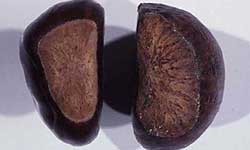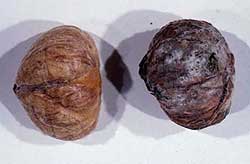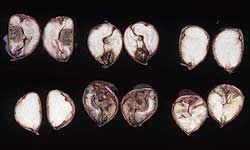Chestnut rot
Chestnut rot is an important post-harvest disease of chestnuts in Australia.
The fungus Gnomoniopsis smithogilvyi was found to be the most often isolated from rotten chestnuts (Shuttleworth et. al. 2013). However, earlier work reported another fungus was responsible, Diaporthe castaneti (Phomopsis castanea).
Chestnut rot has been found to affect all cultivars of chestnut tested, and is present in the major production areas, including:
- Victoria
- New South Wales
- South Australia
- Western Australia.
The disease is also widespread in New Zealand.
Chestnut rot can cause significant losses in nuts. Up to 85 per cent of nuts were diseased in some large consignments of nuts in the market. Because rotten nuts can appear healthy on the outside, special measures are required to ensure consumers buy only good quality nuts.
Symptoms of Chestnut rot
Early stages of rots are even less obvious than advanced cases:

- Small reddish-brown spots might be visible on the pellicle (the papery layer beneath the shell) – this might extend onto the kernel.
- Fine-brown specks or lines might appear inside healthy-looking cream-coloured kernel tissue.
Chestnuts with advanced kernel rot might:
- have a dark shell
- be soft to touch
- appear mouldy.
Badly rotted nut shells might be covered with small raised, cream-coloured structures. These are the fruiting bodies of the causal fungus.

Sometimes these symptoms appear on nuts still in their burrs on the tree, but they are mostly found in consignments of nuts after harvest.
When cut open, rotten chestnuts usually show a tan-brown discolouration of part or the entire nut kernel. Rots can range in colour from chalky-white to dark-brown.

Controlling Chestnut rot
The following practices can reduce the incidence of rots in the marketplace:
- Harvest frequently (daily, if possible) to minimise the delay between nut fall and storage and marketing.
- As for most diseases of stored produce, chestnut rot is restricted by storage at low temperatures (around 0°C) and by maintaining the cold chain during distribution and marketing.
- Check the quality of nuts before marketing – take a random sample of the consignment, cut nuts in half, and assess them for rot development.
Post-harvest and field treatments
The following post-harvest treatments can reduce the incidence of Chestnut rot during storage:
- hot water dips
- modified atmosphere environments prior to storage
- packaging materials.
Currently there are no registered chemicals for the control of chestnut rot.
Chestnut burrs are the source of the infectious spores of Gnomoniopsis smithogilvyi. Those spores have been found to survive for three years in dried burrs under laboratory conditions (Shuttleworth et. al. 2013).
More research is needed but removing or treating the dropped burrs may help manage chestnut rot.
Choosing resistant cultivars
Different cultivars were assessed for comparative rot incidence.
These cultivars showed less rot:
- Purton's Pride
- Red Spanish
- Lucente.
These cultivars showed more rot:
- Marone
- Sword
- Buffalo Queen.
Spread of Chestnut rot
The disease can develop in seedlings grown from infected nuts and can probably also spread in infected nursery stock.
Fungus spores can be water splashed, so dispersal within the canopy of the tree could occur during rainy periods when rotted nuts are still on the tree.
Spread may also occur within post-harvest water handling and by equipment, though the significance of this method is unknown.
Working out exactly where the disease is could be difficult. Infected plants may not show any symptoms (Shuttleworth et. al. 2013).
Disease seems to be favoured by cool, wet summer and autumn weather. Hot-dry conditions during the growing season restrict disease development.
Acknowledgments
Some of this work was part of a project supported by the Horticultural Research and Development Corporation and Chestnuts Australia Inc.
Reporting an unusual plant insect pest or disease
Report any unusual plant pest or disease immediately using our online reporting system or by calling the Exotic Plant Pest Hotline on 1800 084 881. Early reporting increases the chance of effective control and eradication.
Please take multiple good quality photos of the pests or damage to include in your report where possible, as this is essential for rapid pest and disease diagnosis and response.
Your report will be responded to by an experienced staff member who may seek more information about the detection and explain next steps.
Report onlineReference
Shuttleworth, L. A., Liew, E. C. Y. and Guest, D. I. (2013) Survey of the incidence of chestnut rot in south-eastern Australia. Australasian Plant Pathology 42:63–72.